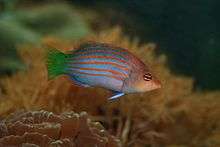Six-line wrasse
| Six-line wrasse | |
|---|---|
 | |
| Scientific classification | |
| Kingdom: | Animalia |
| Phylum: | Chordata |
| Class: | Actinopterygii |
| Order: | Perciformes |
| Family: | Labridae |
| Genus: | Pseudocheilinus |
| Species: | P. hexataenia |
| Binomial name | |
| Pseudocheilinus hexataenia (Bleeker, 1857) | |
| Synonyms | |
| |
The six-line wrasse, Pseudocheilinus hexataenia, is a species of wrasse native to the Indian Ocean and the western Pacific Ocean. This species inhabits coral reefs at depths from 1 to 35 m (3.3 to 114.8 ft). It can reach 10 cm (3.9 in) in total length. It can also be found in the aquarium trade.[2]
Behavior
The six-line wrasse is a semi-aggressive fish. It will compete with and harass delicate fish or smaller individuals. Since it has a ravenous appetite for small benthic creatures and crustaceans, it can easily deplete the marine biodiversity in its environment. However, it can also be a cleaner fish. Six-line wrasse will also peck algae, parasites and fish eggs off of rocks, coral and seaweed in its quest for small crustaceans.[3]
Food and Health
Six-lined wrasse specialize mostly in eating small benthic organisms, especially crustaceans. They seem to prefer amphipods, copepods, benthic-stage lobster larvae, small shrimp and fish eggs. They will also peck algae for extra nutrients and also because tasty morsels easily get stuck in the slimy goop. Six-line wrasse rarely get parasites since they eat the parasites themselves. There has been no specific documentation of this species succumbing to a disease such as saltwater ich, as they are extremely hardy fish.[4] In captivity, they can be fed frozen or live food.
Danger Alert
So far there have been no documented natural predators of the six-lined wrasse, but occasionally a frogfish, stonefish or lionfish has been observed eating one in captivity.
Home base
Six-line wrasse inhabit warm tropical waters around the islands of Indonesia and Oceania, and have also been observed around various islets and seamounts in the Pacific Ocean
Captivity
Six-lined wrasse are vibrant, colorful, hardy, disease and parasite resistant and inexpensive, tempting beginning and experienced aquarists alike to move one to their tank. Big mistake. These semi-aggressive fish will fight with, injure, and kill delicate, weak, old, baby or small fish and are best kept with other semi-aggressive fish like clowns or damsels. A single-species tank is okay, too, but keep in mind that "a wrasse will harass." Wrasses are best kept alone unless they're different species, and if you're planning to keep one with fish like mandarins, tangs, or gobies, put it in last. As in the wild, captive fish have territories, too. Delicate or small fish tend to only shoo intruders away and may allow certain species in. Semi- aggressive or aggressive fish will defend their territory fiercely. If an aggressive or semi-aggressive fish is introduced to the tank first or at the same time as other fish, it will see its territory as the whole tank and attack other "invading" fish. If such a fish is put in last, it has no territory to defend and won't bother anyone. But be careful of the timing, as any peaceful or non-aggressive fish is introduced after that, the aggressive chaps and sometimes even the whole tank will fight. Sometimes, a certain species of fish is incompatible with another type whatsoever. To ensure that your future tankmates will be safe from each other, you can check the saltwater or freshwater fish compatibility charts on liveaquaria.com.[5]
References
- ↑ Bertoncini, A. 2010. Pseudocheilinus hexataenia. In: IUCN 2013. IUCN Red List of Threatened Species. Version 2013.1. <www.iucnredlist.org Archived June 27, 2014, at the Wayback Machine.>. Downloaded on 15 November 2013.
- ↑ Froese, Rainer and Pauly, Daniel, eds. (2013). "Pseudocheilinus hexataenia" in FishBase. October 2013 version.
- ↑ youtube.com/coralfish12g
- ↑ liveaquaria.com
- ↑ liveaquaria.com
